In this guide, I am taking a look at the official Raspberry Pi touchscreen. This screen is perfect for anyone looking for a touch solution for their next project or would just like to extend the Pi’s functionality.
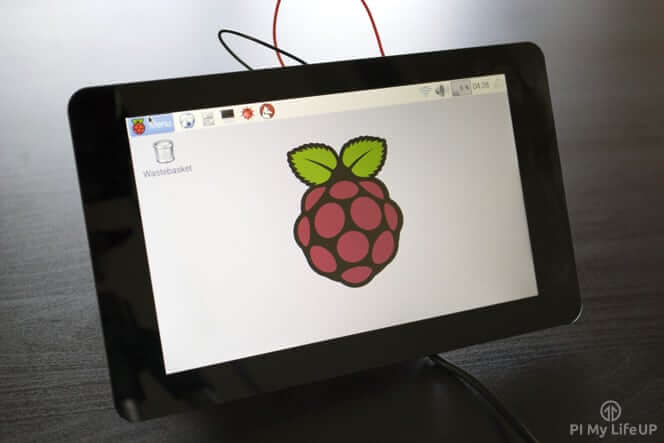
Throughout this guide, I will take you through everything you will need to know about this touchscreen. We will touch on what exactly it is, how to put it together, the look & feel and finally how much you can expect to pay for the device.
There are many reasons why you may want to pick up the touchscreen but being able to use touch-enabled apps is one of the best reasons. I am currently using mine with a touch version of Octoprint.
I hope I touch on as many points as possible in this guide. If you feel that I have missed something, then please don’t hesitate to leave a comment.
Video
If you want to hear me talk about the Raspberry Pi touchscreen display, then be sure to check out the video I have prepared below.
If you do like the video, then be sure to subscribe to stay up to date on all our Pi projects, guides and much more.
What Is the Raspberry Pi Touchscreen
The Raspberry Pi touchscreen display is the first official screen for the Pi. The screen size sits at 7 inches and can support ten fingers capacitive touch. It communicates over the DSI port so you won’t need to worry about it using up your HDMI port or the GPIO pins.
There are many great things you will be able to do with a Touchscreen on your Pi. This range of things includes lots of cool embedded projects such as home automation. You can also use it just as a touch-enabled alarm clock and much more.
At the writing of this guide, the screen will not work with the older models of the Raspberry Pi. It includes both the Raspberry Pi model A or B. This may change in the future.
It is also important to know that Raspbian isn’t a touch-friendly operating system. If you’re looking for a convenient tablet such as the many Android and Apple tablets out there you may want to pass on this. If you’re looking to make cool embedded projects or just play around with it, then the screen is perfect.
How to Put It Together
Putting the Raspberry Pi Touch display together is pretty easy. Surprisingly there are no instructions that come with the device. I will guide you through the process below. If you rather see it visually be sure to check out the video above (It is probably a lot easier to understand).
1. Firstly, safely remove all the parts from the packaging.
2. Place the touch-screen face down onto table or bench. Make sure the surface won’t scratch the screen.
3. Next, connect the large ribbon cable to the large ribbon cable slot on the bottom of the display board. (When connecting ribbon cables make sure the tab is released)
4. Now, connect the small ribbon cable to the small ribbon cable slot located on the top of the board.
5. Next, screw in the four standoff screws. These screws will connect the display board to the screen.
6. Now, place the Raspberry Pi on top of the standoff screws with the DSI port on the same end of the display board DSI port. Screw the four screws in securing the Pi to the board.
7. Now, using the ribbon cable, connect the display board to the Raspberry Pi. Make sure you connect this cable to the DSI port on both the display board and the Raspberry Pi.
8. Finally, you can move onto powering the device.
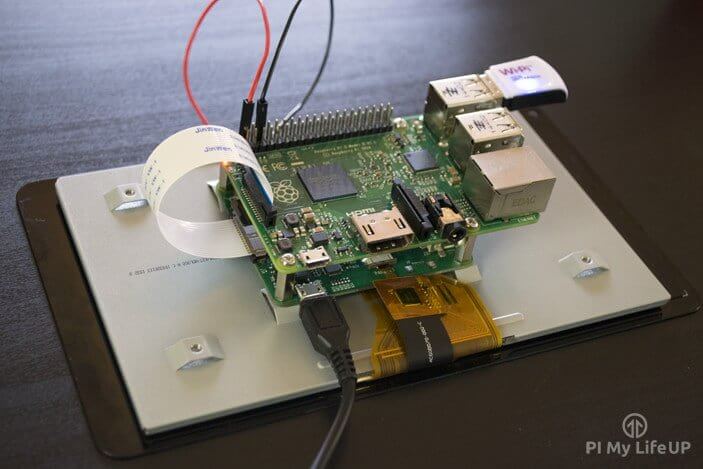
Power the Device
There are three ways you’re able to power the touch display.
The first option is to power it using a separate power supply for each device. This option is perfect if you want both the Pi and the touchscreen powered independently. You will need to use a USB power supply with a rating of at least 500mA. Just enter the USB into PWR IN port.
The second option is to power the touchscreen or Pi then use a USB link to power the other board.
The third option is to use GPIO jumpers. Simply connect the 5v (Pin 2) and a ground pin (pin 6) from the Raspberry Pi GPIO pins to the relevant pins on the display board (They are clearly marked).
It is important to make sure you have a powerful enough power supply if powering both the device from the one source.
Turning It On
If you have turned your Raspberry Pi and there is no output on the touchscreen, or there are other issues, then it is likely your operating system is out of date. This issue is a super easy fix, just run the following commands if you need to update your Pi.
sudo apt update
sudo apt upgradeCopyOnce done restart the Pi by using the following command:
sudo rebootCopyNow once this has been done your screen should come to life and be usable.
By default, the touchscreen will become the default display. If you do not wish this to be the case, you will need to add a line to the config.txt file. To do this enter the following:
sudo nano /boot/config.txtCopyIn here add the following line. (Bottom of the file is probably the best place to put this)
display_default_lcd=0CopyNow reboot the Pi and if you have an HDMI cord plugged in it will be displayed through that.
If you want the touchscreen to become the default display again, you will need to either remove or comment this line out of the config file.
Onscreen Keyboard
If you want an onscreen keyboard for your touchscreen, then you will need to install it. This process is pretty straightforward.
Either via SSH or in the terminal enter the following command.
sudo apt install matchbox-keyboardCopyOnce it has installed, restart the Pi.
The application will be available in the keyboard menu located in menu -> Accessories -> Keyboard.
If it doesn’t display you will need to go to the main menu editor (Menu-> Preferences-> main menu editor) and then make a small change. Once you have done this, reboot the Pi.
After the reboot now make a small change again (Probably best to revert what you just did). After you have done this, the keyboard icon should now be displayed.
Look & Feel
The screen itself is nice and sleek and the display quality is decent. The screen responds well to touch and doesn’t appear to have any display issues.
The downside is this doesn’t come with a case leaving your Raspberry Pi and the touchscreen circuitry exposed.
Unfortunately, there also seems to be a lack of cases to buy on the current market. The lack of cases is disappointing if you want to make your Pi look good.

A lot of suggestions is to get one 3D printed, but if you don’t have access to a 3D printer, then this can be quite difficult and expensive.
If you’re happy with just a frame and stand, then you can find some nice designs over at Pimoroni.
If you want to save some money, you can always make a case or stand from scratch. I have seen some pretty cool DIY cases for the touch screen around.
How Much is it?
Now you can find this device for roughly about £48.0 or roughly $80 USD (Subject to change). Now depending on how you plan on using it this may or may not be worth the money. If you do want a case, you will need to factor some extra money for that as well.
There are some other competitors 3rd party touchscreens out there, but if you’re after the official screen that is guaranteed to work on the latest Raspberry Pi’s, then this is the one to get.
Buy The Raspberry Pi Touchscreen
If you have your own thoughts on the Raspberry Pi Touchscreen, then be sure to drop me a comment below.
Affiliate link disclaimer: All the products I mention on this website I have personally purchased and used at least once. Some of the links on this website are affiliate links that earn me a small commission whenever a sale is made.
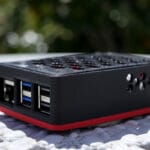
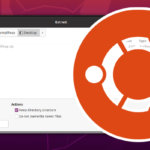
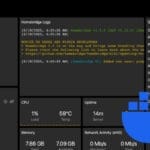
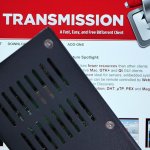
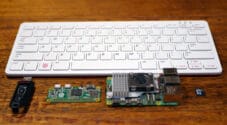
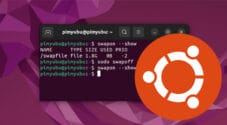


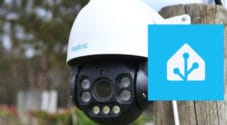
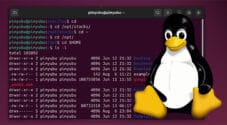
Where is the video ?
You’re likely running an adblocker. Adblock removes the video player.
I bought a Pi 7″ touchscreen and a premium case. Unfortunately the display is upside down. I’ve seen a fix for this somewhere (apart from turning it the other way up) but can’t remember where. Would it be possible to include this in your guide?
PS You hardly ever seem to reply to comments 🙁
write into your config.txt
lcd_rotate=2
that rotates the screen 180 degree
Hello,
I bought the same touchscreen display but for the moment, i don’t have the raspberry pi 3. So i try to work with the first raspberry pi.
I had installed raspbian jessie and i wrote all of this:
sudo apt-get updatesudo apt-get upgrade
sudo apt-get dist-upgrade
sudo apt-get install raspberrypi-ui-mods
sudo apt-get install raspberrypi-net-mods
But my touchscreen doesn’t work yet.
Do you have some advice for this problem?
The new 7″ touchscreen display can work with raspberry pi 1?
Thank you for your help!!
Gus’s review says ‘At the writing of this guide the screen will not work with the older models of the Raspberry Pi. This includes both the Raspberry Pi model A or B. This may change in the future.’
Therefore I would assume that it won’t work with a Pi 1
Can you make some suggestions about these other alternatives? Perhaps something a bit smaller?